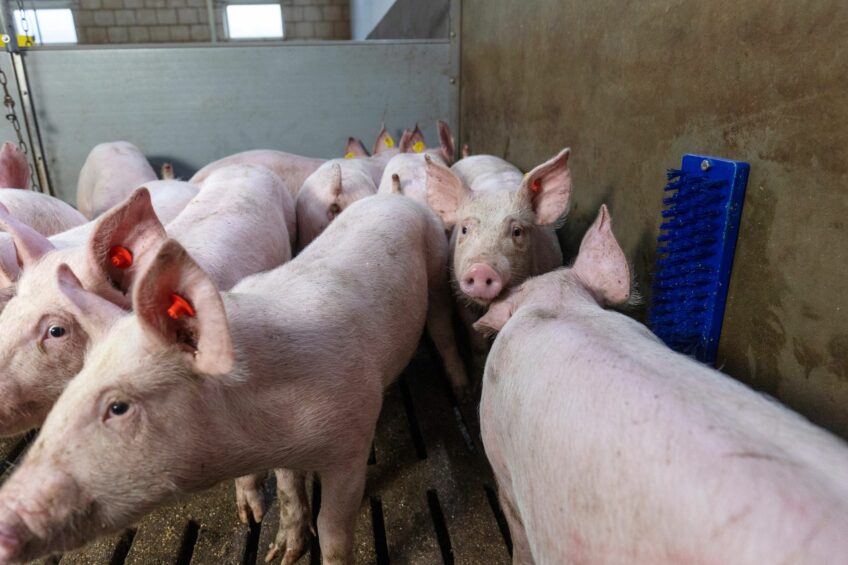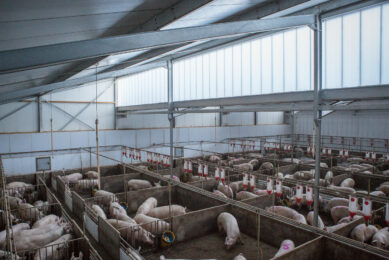Sling belt provision enhances pig welfare in intensive farming

Researchers from South Korea evaluated the impact of a sling belt on pig behaviour, the number of skin lesions, and saliva cortisol levels after transport and regrouping.
During the growing–finishing phase, regrouping after transport leads to aggression in intensive pig production systems. This is due to the establishment of a social hierarchy among unfamiliar pigs. Increased aggression results in skin lesions, lower growth, and compromised welfare. Providing environmental enrichment materials reduces stress and aggressive behaviour, and improves pig welfare. Application of materials such as straw, compost, silage, metal chains, and plastic toys has limitations for fulfilling the behavioural needs of pigs. A sling belt is a cost-effective alternative attached to the wall. It minimises the risk of contamination by manure. Moreover, the soft and flexible materials in sling belts enable pigs to easily manipulate them.
Data collection
The research team used of 571 female and castrated male pigs ((Landrace × Yorkshire) × Duroc) from 3 batches for this trial. All pigs were weaned at 28 days of age and then housed in weaning pig pens for 6 weeks. They transported the pigs for 150 km for about 2 hours. The farm staff arbitrarily regrouped pigs that arrived at the experimental farm, irrespective of sex. The team divided each batch into 3 groups. They allotted each group randomly to one of the following 3 treatments: 1) control group, 2) provision of 5–6 sling belts per group, and 3) provision of 10–12 sling belts per group.
The team recorded the body weight of all pigs on days 0 and 6 after regrouping. The skin lesions on 5 parts of the pig’s body including ear, front, middle, hindquarters, and legs were assessed.
The team monitored the pigs’ behaviour for 24 hours after transport and regrouping. To do this, they used an internet protocol camera. They collected saliva samples without restraint from selected pigs to measure cortisol level.
Impact on growth performance
Providing sling belts did not affect the body weights, average daily gain, and the tail lesion score of pigs after transport and regrouping. The researchers intended to minimise additional stress on pigs due to disturbance in the pen for long periods of sampling time. Therefore, they limited sampling to 3 pigs in each pen. In addition, the short experimental period limited thorough evaluation of growth performance and tail lesions. Moreover, the pigs had their tails docked to within 3 cm, which probably contributed to the absence of tail lesions during the experimental period.
Therefore, further studies are needed to determine the long-term effects of sling belt provision. Although, the provision of 10–12 sling belts per group increased the proportion of pigs with skin lesion score of 0 and decreased the proportion of pigs with score 1.
Impact on behaviour
The provision of 10–12 sling belts per group had a more significant impact on the reduction of injurious interaction during 24 hours after regrouping. This finding suggests that providing an adequate amount of environmental enrichment materials based on the number of pigs per pen is essential to ensure pigs have access to a single sling belt without competition to reduce aggression. Less aggressive behavior was correlated with increased manipulation behavior because aggressive behavior is redirected towards environmental enrichment materials manipulation. Proving sling belt decreased exploratory behavior directed towards pen features, such as feeder, fence and floor, and the proportion of pigs with skin lesions but increased rest, sleep, or inactivity.
Impact on salivary cortisol levels
The provision of 10–12 sling belts per group significantly lowered cortisol levels in pigs because the pigs in this group had more opportunities to access sling belts without competition. The increase in salivary cortisol levels had a positive correlation with the proportion of pigs displaying injurious interaction and a negative correlation with the proportion of pigs showing manipulation behavior towards the sling belts. One possible mechanism underlying this relation is that the rise in salivary cortisol is influenced by responses coupled to the skin lesions. In addition, cortisol levels can be increased by anti-inflammatory effects that follow a systemic inflammatory stimulus.
Conclusion
The authors concluded that providing sling belts is linked to various behavioural changes. These lead to reduced aggression and stress activity in pigs after transport and regrouping.











